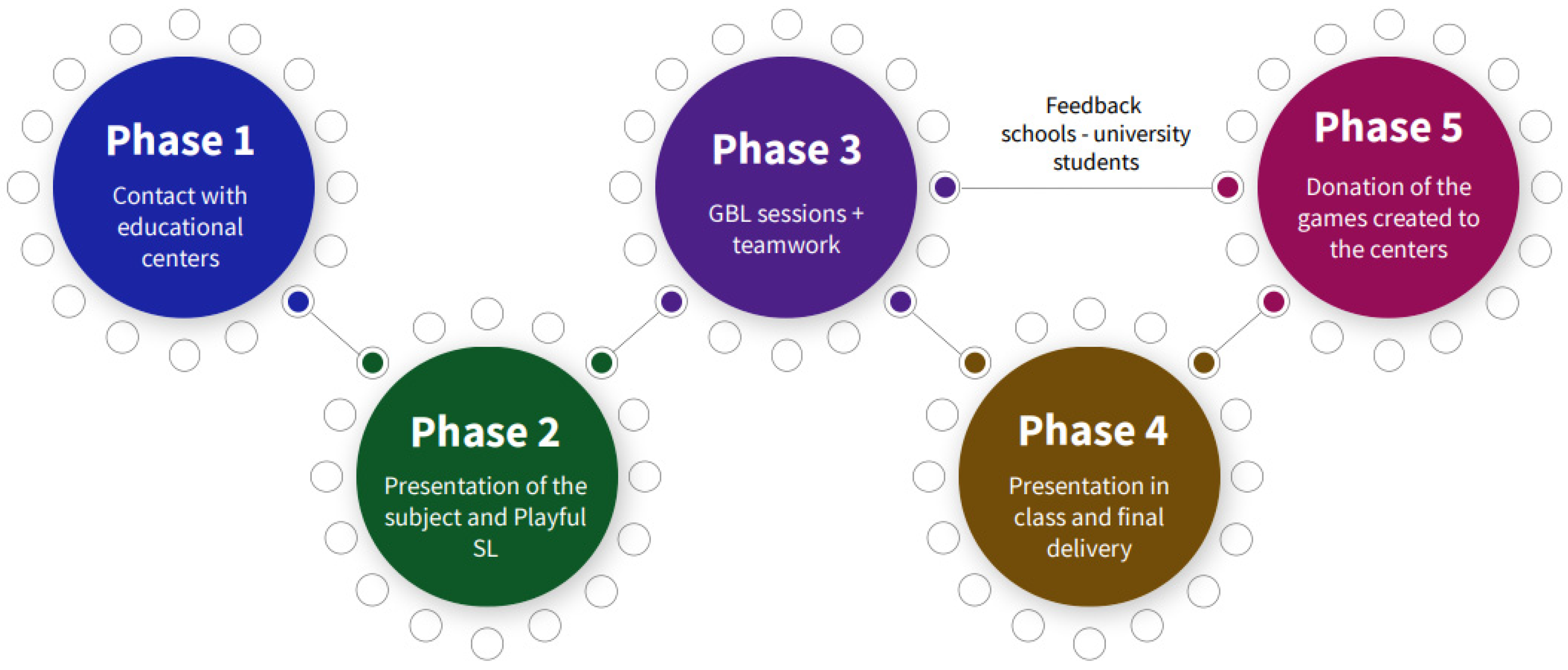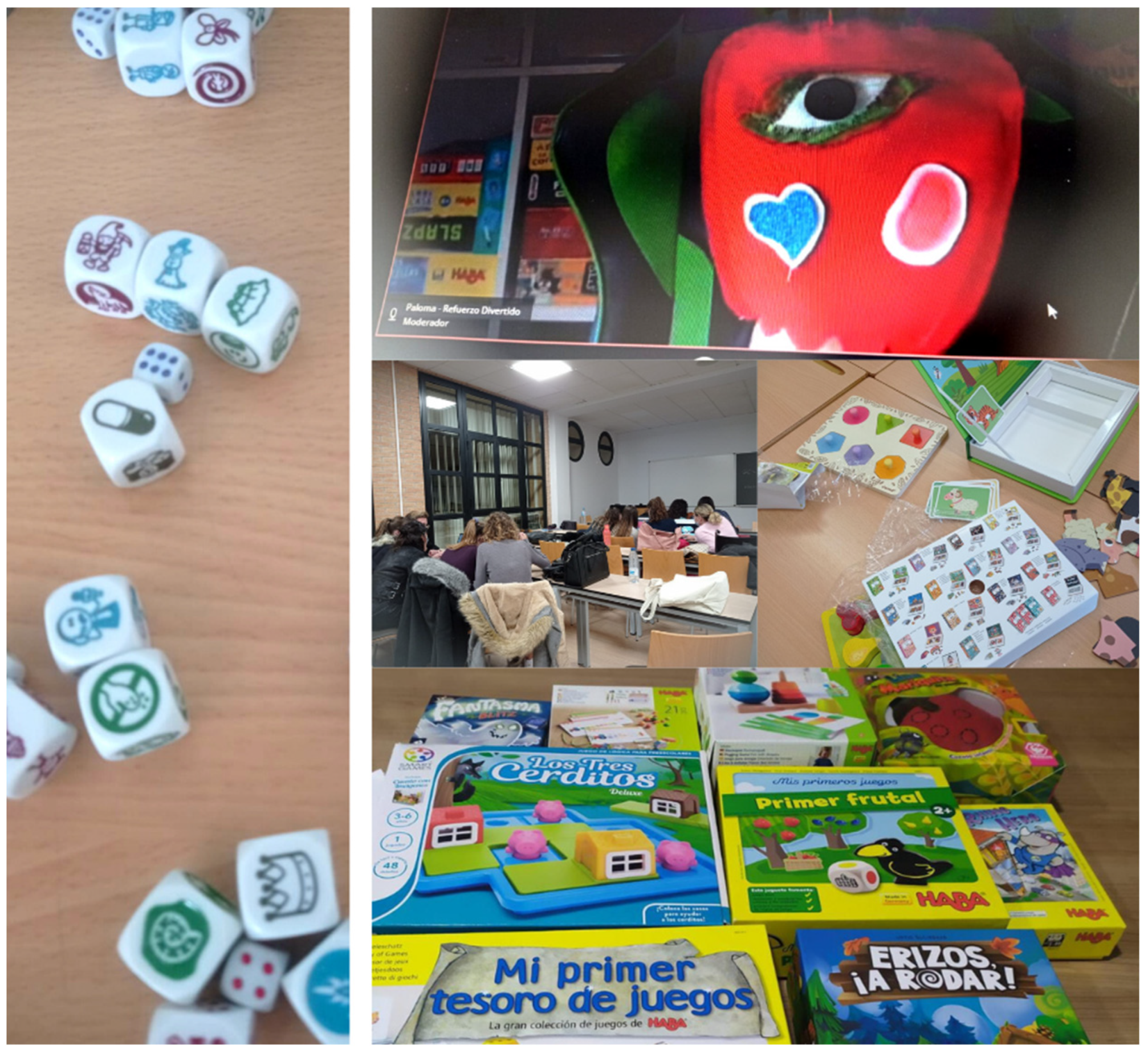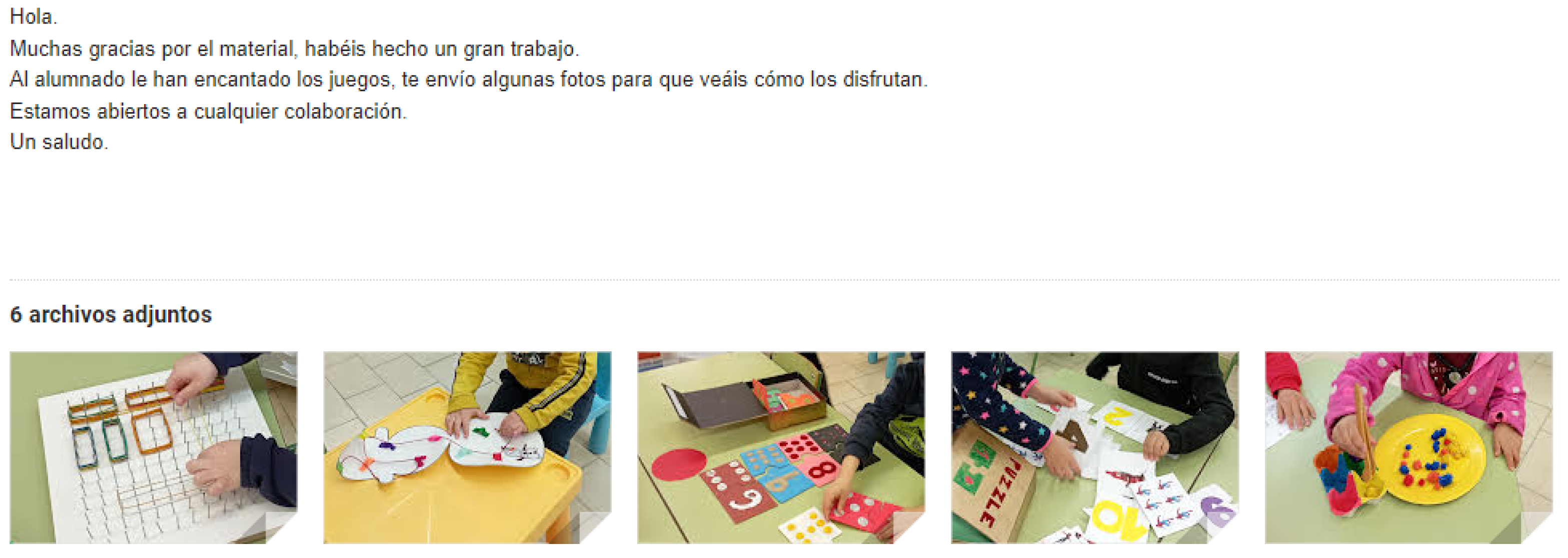Game-Based Learning and Service-Learning to Teach Inclusive Education in Higher Education
Abstract
1. Introduction
2. Materials and Methods
2.1. Participants
2.2. Instruments
2.3. Procedure
2.4. Data Analysis
3. Results
4. Discussion and Conclusions
Author Contributions
Funding
Institutional Review Board Statement
Informed Consent Statement
Data Availability Statement
Conflicts of Interest
References
- Martínez, M. Aprendizaje Servicio y Responsabilidad Social de las Universidades; Editorial Octaedro: Barcelona, Spain, 2008. [Google Scholar]
- Gelmon, S.B.; Holland, B.A.; Spring, A. Assessing Service-Learning and Civic Engagement: Principles and Techniques; Stylus Publishing, LLC.: Sterling, VA, USA, 2018. [Google Scholar]
- Molderez, I.; Fonseca, E. The efficacy of real-world experiences and service learning for fostering competences for sustainable development in higher education. J. Clean. Prod. 2018, 172, 4397–4410. [Google Scholar] [CrossRef]
- Celio, C.I.; Durlak, J.; Dymnicki, A. A Meta-Analysis of the Impact of Service-Learning on Students. J. Exp. Educ. 2011, 34, 164–181. [Google Scholar] [CrossRef]
- Huda, M.; Mat Teh, K.S.; Nor Muhamad, N.H.; Mohd Nasir, B. Transmitting leadership based civic responsibility: Insights from service learning. Int. J. Ethics Syst. 2018, 34, 20–31. [Google Scholar] [CrossRef]
- Norman, Z. Understanding the Effect of Service-Learning Experiences on Students’ Cultural Competence in Higher Education; Gonzaga University: Spokane, WA, USA, 2018. [Google Scholar]
- Fernández, D.L.; Raya, L.; Ortega, F.; García, J.J. Project based learning meets service learning on software development education. Int. J. Eng. Educ. 2019, 35, 1436–1445. [Google Scholar]
- Diaz Fernandez, A. Pandemic Times: Knowledge Management and Technology in service Learning. Rev. Virtual Univ. Catol. Del. Norte 2021, 63, 1–4. [Google Scholar] [CrossRef]
- Meletiou-Mavrotheris, M.; Prodromou, T. Pre-Service Teacher Training on Game-Enhanced Mathematics Teaching and Learning. Technol. Knowl. Learn. 2016, 21, 379–399. [Google Scholar] [CrossRef]
- Resch, K.; Schrittesser, I. Using the Service-Learning approach to bridge the gap between theory and practice in teacher education. Int. J. Incl. Educ. 2021, 1–15. [Google Scholar] [CrossRef]
- Aramburuzabala, P.; McIlrath, L.; Opazo, H. Embedding Service Learning in European Higher Education: Developing a Culture of Civic Engagement; Routledge: New York, NY, USA, 2019. [Google Scholar]
- Mesurado, B.; Distefano, M.J.; Robiolo, G.; Richaud, M.C. The Hero program: Development and initial validation of an intervention program to promote prosocial behavior in adolescents. J. Soc. Pers. Relatsh. 2018, 36, 2566–2584. [Google Scholar] [CrossRef]
- Saylor, J.; Hertsenberg, L.; McQuillan, M.; O’Connell, A.; Shoe, K.; Calamaro, C.J. Effects of a service learning experience on confidence and clinical skills in baccalaureate nursing students. Nurse Educ. Today 2018, 61, 43–48. [Google Scholar] [CrossRef]
- Richards, K.A.R.; Eberline, A.D.; Sookhenlall, P.; Templin, T.J. Experiential Learning Through a Physical Activity Program for Children With Disabilities. J. Teach. Phys. Educ. 2014, 34, 165–188. [Google Scholar] [CrossRef]
- Rodríguez Garcés, C.; Castillo Riquelme, V. Calidad en la formación inicial docente: Los déficits de las competencias pedagógicas y disciplinares en Chile. Actual. Investig. Educ. 2014, 14, 373–399. [Google Scholar]
- Carr, V.; Luken, E. Playscapes: A pedagogical paradigm for play and learning. Int. J. Play. 2014, 3, 69–83. [Google Scholar] [CrossRef]
- Marín, I. ¿Jugamos? Como el Aprendizaje Lúdico puede Transformar la Educación; PAIDÓS Educación: Bogotá, Colombia, 2018. [Google Scholar]
- Vidal Carulla, C.; Christodoulakis, N.; Adbo, K. Development of preschool children’s executive functions throughout a play-based learning approach that embeds science concepts. Int. J. Environ. Res. Public Health 2021, 18, 588. [Google Scholar] [CrossRef]
- Sánchez Montero, M. En Clase sí se Juega. Una Guía Práctica para Utilizar y Crear Juegos en el Aula; PAIDÓS Educación: Bogotá, Colombia, 2021. [Google Scholar]
- Rushton, S.; Juola-Rushton, A.; Larkin, E. Neuroscience, play and early childhood education: Connections, implications and assessment. Early Child. Educ. J. 2010, 37, 351–361. [Google Scholar] [CrossRef]
- Nwokah, E.E.; Becerril, S.; Hardee, W.P.; Brito, E. Play with homeless and low-income preschoolers: University student experiences with service learning. Int. J. Play. 2017, 6, 53–77. [Google Scholar] [CrossRef]
- Aguilar, A.F.G.; Ramos, A.F.A. Implementing a gamification methodology to motivate reading and writing in young university students. Kepes 2016, 13, 61–81. [Google Scholar] [CrossRef]
- Boytchev, P.; Boytcheva, S. Gamified Evaluation in STEAM for Higher Education: A Case Study. Information 2020, 11, 316. [Google Scholar] [CrossRef]
- Macías-Guillén, A.; Díez, R.M.; Serrano-Luján, L.; Borrás-Gené, O. Educational Hall Escape: Increasing Motivation and Raising Emotions in Higher Education Students. Educ. Sci. 2021, 11, 527. [Google Scholar] [CrossRef]
- Bringle, R.G.; Ruiz, A.I.; Brown, M.A.; Reeb, R.N. Enhancing the Psychology Curriculum Through Service Learning. Psychol. Learn. Teach. 2016, 15, 294–309. [Google Scholar] [CrossRef]
- Alsawaier Raed, S. The effect of gamification on motivation and engagement. Int. J. Inf. Learn. Technol. 2018, 35, 56–79. [Google Scholar] [CrossRef]
- Chang, M.; Evans, M.A.; Kim, S.; Norton, A.; Deater-Deckard, K.; Samur, Y. The effects of an educational video game on mathematical engagement. Educ. Inf. Technol. 2016, 21, 1283–1297. [Google Scholar] [CrossRef]
- Courville, K.A.; Lowe, A.; Dannelley, B.; Sellers, J.; Deal, B. Learning-by-Teaching and Service Learning to Promote Bleeding Control Education: An Academic-Community Partnership. Nurse Educ. 2021. [Google Scholar] [CrossRef] [PubMed]
- Halberstadt, J.; Timm, J.-M.; Kraus, S.; Gundolf, K. Skills and knowledge management in higher education: How service learning can contribute to social entrepreneurial competence development. J. Knowl. Manag. 2019, 23, 1925–1948. [Google Scholar] [CrossRef]
- Palpacuer Lee, C.; Curtis, J.H.; Curran, M.E. Shaping the vision for service-learning in language education. Foreign Lang. Ann. 2018, 51, 169–184. [Google Scholar] [CrossRef]
- Ferrer, J.; Ringer, A.; Saville, K.; Parris, M.; Kashi, K. Students’ motivation and engagement in higher education: The importance of attitude to online learning. High. Educ. 2020, 83, 317–338. [Google Scholar] [CrossRef]
- Manzano-León, A.; Rodríguez-Ferrer, J.M.; Aguilar-Parra, J.M.; Trigueros, R.; Díaz-López, M.P.; Torres-López, N.; Fernández-Jiménez, C. Testing the Factorial Validity of the Classroom Engagement Inventory with Spanish Students. Psychol. Res. Behav. Manag. 2021, 14, 1011–1018. [Google Scholar] [CrossRef]
- Nakamura, J.; Csikszentmihalyi, M. The Concept of Flow. In Flow and the Foundations of Positive Psychology: The Collected Works of Mihaly Csikszentmihalyi; Csikszentmihalyi, M., Ed.; Springer: Dordrecht, The Netherlands, 2014; pp. 239–263. [Google Scholar]
- Akman, E.; Çakir, R. Pupils’ opinions on an educational Virtual Reality game in terms of flow experience. Int. J. Emerg. Technol. Learn. 2019, 14, 121–137. [Google Scholar] [CrossRef]
- Bressler, D.M.; Bodzin, A.M. A mixed methods assessment of students’ flow experiences during a mobile augmented reality science game. J. Comput. Assist. Learn. 2013, 29, 505–517. [Google Scholar] [CrossRef]
- Huang, H.C.; Pham, T.T.L.; Wong, M.K.; Chiu, H.Y.; Yang, Y.H.; Teng, C.I. How to create flow experience in exergames? Perspective of flow theory. Telemat. Inform. 2018, 35, 1288–1296. [Google Scholar] [CrossRef]
- Ninaus, M.; Moeller, K.; McMullen, J.; Kiili, K. Acceptance of Game-Based Learning and Intrinsic Motivation as Predictors for Learning Success and Flow Experience. Int. J. Serious Games 2017, 4, 15–30. [Google Scholar] [CrossRef]
- Silva, R.; Rodrigues, R.; Leal, C. Play it again: How game-based learning improves flow in Accounting and Marketing education. Account. Educ. 2019, 28, 484–507. [Google Scholar] [CrossRef]
- Manzano-León, A.; Ortiz-Colón, A.M.; Rodríguez-Moreno, J.; Aguilar-Parra, J.M. La relación entre las estrategias lúdicas en el aprendizaje y la motivación: Un estudio de revisión. Rev. Espac. 2022, 43, 29–45. [Google Scholar] [CrossRef]
- Csikszentmihalyi, M. Flow: The Psychology of Optimal Experience; First Harper Perennial Modern Classics: New York, NY, USA, 2008. [Google Scholar]
- Sillaots, M. Achieving Flow through Gamification: A study on Re-Designing Research Methods Courses; Academic Conferences International Limited: Reading, UK, 2014; Volume 2. [Google Scholar]
- Froehlich, D.E.; Hobusch, U.; Moeslinger, K. Research Methods in Teacher Education: Meaningful Engagement through Service-Learning. Front. Educ. 2021, 6, 680404. [Google Scholar] [CrossRef]
- Jacobs, A. The benefits of experiential learning during a service-learning engagement in child psychiatric nursing education. Afr. J. Health Prof. Educ. 2020, 12, 81–85. [Google Scholar] [CrossRef]
- Kwenani, D.F.; Yu, X. Maximizing international students’ service-learning and community engagement experience: A case study of student voices on the benefits and barriers. J. High. Educ. Outreach Engagem. 2018, 22, 29–52. [Google Scholar]
- Varela-Candamio, L.; Enríquez-Díaz, J.; Rouco-Couzo, M. Gamification in service learning: An innovative experience. In Research Anthology on Service Learning and Community Engagement Teaching Practices; IGI Global: Hershey, PA, USA, 2022; pp. 704–727. [Google Scholar]
- Capella Peris, C.; Salvador García, C.; Chiva-Bartoll, Ò.; Ruiz Montero, P.J. Alcance del aprendizaje-servicio en la formación inicial docente de educación física: Una aproximación metodológica mixta. Challenges 2020, 37, 465–472. [Google Scholar]
- Hernández-Sampieri, R.; Fernández-Collado, C.; Baptista-Lucio, P. Metodología de la Investigación; McGraw Hill Education: New York, NY, USA, 2014. [Google Scholar]
- Vizcarra Morales, M.T.; Nuño Angos, T.; Lasarte Leonet, M.G.; Aristizabal Llorente, M.P.; Alvarez Uria, A. La perspectiva de género en los títulos de Grado en la Escuela Universitaria de Magisterio de Vitoria-Gasteiz. Red U Rev. Docencia Univ. 2015, 13, 297–318. [Google Scholar] [CrossRef]
- Calero, A.; Injoque-Ricle, I. Propiedades psicométricas del Inventario Breve de Experiencias Óptimas (Flow). Rev. Evaluar 2013, 13, 40–56. [Google Scholar] [CrossRef]
- Wang, Z.; Bergin, C.; Bergin, D. Measuring Engagement in Fourth to Twelfth Grade Classrooms: The Classroom Engagement Inventory. Sch. Psychol. Q. Off. J. Div. Sch. Psychol. Am. Psychol. Assoc. 2014, 29, 517–535. [Google Scholar] [CrossRef]
- Cortés Díaz, M.; Ferreira Villa, C.; Arias Gago, A.R. Fundamentos del Diseño Universal para el Aprendizaje Desde la Perspectiva Internacional. Rev. Bras. Educ. Espec. 2021, 27, 269–284. [Google Scholar] [CrossRef]
- Balaguer Fàbregas, M.C.; Fuentes Loss, M.; Palau Royo, M. La competencia comunicativa oral en la formación de maestros y maestras. Opción 2015, 31, 15. [Google Scholar]
- Cabedo, L.; Royo, M.; Moliner, L.; Guraya, T. University social responsibility towards engineering undergraduates: The effect of methodology on a service-learning experience. Sustainability 2018, 10, 1823. [Google Scholar] [CrossRef]
- Chernikova, O.; Heitzmann, N.; Stadler, M.; Holzberger, D.; Seidel, T.; Fischer, F. Simulation-based learning in higher education: A meta-analysis. Rev. Educ. Res. 2020, 90, 499–541. [Google Scholar] [CrossRef]
- Kaufman, D.; Ireland, A. Enhancing Teacher Education with Simulations. TechTrends 2016, 60, 260–267. [Google Scholar] [CrossRef]
- Nadolski, R.J.; Hummel, H.G.K.; van den Brink, H.J.; Hoefakker, R.E.; Slootmaker, A.; Kurvers, H.J.; Storm, J. EMERGO: A methodology and toolkit for developing serious games in higher education. Simul. Gaming 2007, 39, 338–352. [Google Scholar] [CrossRef]
- Rooney, D.; Hopwood, N.; Boud, D.; Kelly, M. The role of simulation in pedagogies of higher education for the health professions: Through a practice-based lens. Vocat. Learn. 2015, 8, 269–285. [Google Scholar] [CrossRef]
- Myers, M.D. Student development in service learning: A literature review of service learning and self-authorship. Coll. Stud. J. 2020, 54, 126–140. [Google Scholar]
- Gallini, S.M.; Moely, B.E. Service-learning and engagement, academic challenge, and retention. Mich. J. Community Serv. Learn. 2003, 10, 5–14. [Google Scholar]
- Gu, J.; Xue, Q.; Lu, R. Investigating the structural relationships among environmental factors, learning flow and learning transfer in service learning. IETI Trans. Soc. Sci. Humanit. 2019, 5, 203–209. [Google Scholar]



| Control Group | Experimental Group | |||||||
|---|---|---|---|---|---|---|---|---|
| Variables | Pre-M | DT | Post-M | DT | Pre-M | DT | Post-M | DT |
| Flow | 30.07 | 5.30 | 30.74 | 5.73 | 30.55 | 4.46 | 35.05 | 3.41 |
| C | 17.95 | 3.41 | 18.91 | 3.23 | 18.14 | 2.13 | 22.41 | 2.32 |
| A.E. | 16.83 | 3.38 | 16.76 | 2.90 | 17.02 | 3.08 | 19.80 | 2.20 |
| B.E. | 16.31 | 3.29 | 16.91 | 3.07 | 16.45 | 3.05 | 20.30 | 2.54 |
| C.E. | 32.37 | 6.56 | 32.24 | 5.84 | 33.02 | 6.38 | 42.20 | 6.78 |
| D | 6.36 | 2.55 | 7.89 | 2.80 | 6.13 | 2.77 | 4.69 | 1.84 |
| Variable | t | p |
|---|---|---|
| Flow | 0.505 | 0.615 |
| Compliance | 0.365 | 0.715 |
| Affective engagement | 0.315 | 0.753 |
| Behavior engagement | 0.231 | 0.817 |
| Cognitive engagement | 0.532 | 0.596 |
| Disengagement | −0.478 | 0.633 |
| Intra | Inter | |||||
|---|---|---|---|---|---|---|
| Variable | F | p | Post Hoc | F | p | Post Hoc |
| Flow | 34.60 | *** | Exp *** | 7.95 | 0.006 | Exp *** |
| Compliance | 41.02 | *** | Exp *** | 16.27 | *** | Exp *** |
| Affective engagement | 32.27 | *** | Exp *** | 10.83 | 0.001 | Exp *** |
| Behavior engagement | 150.40 | *** | Exp *** | 176.95 | *** | Exp *** |
| Cognitive engagement | 1221.93 | *** | Exp *** | 68.29 | *** | Exp *** |
| Disengagement | 51.15 | *** | Cont *** | 16.94 | *** | Exp *** Cont *** |
Disclaimer/Publisher’s Note: The statements, opinions and data contained in all publications are solely those of the individual author(s) and contributor(s) and not of MDPI and/or the editor(s). MDPI and/or the editor(s) disclaim responsibility for any injury to people or property resulting from any ideas, methods, instructions or products referred to in the content. |
© 2023 by the authors. Licensee MDPI, Basel, Switzerland. This article is an open access article distributed under the terms and conditions of the Creative Commons Attribution (CC BY) license (https://creativecommons.org/licenses/by/4.0/).
Share and Cite
Rodríguez-Ferrer, J.M.; Manzano-León, A.; Aguilar-Parra, J.M. Game-Based Learning and Service-Learning to Teach Inclusive Education in Higher Education. Int. J. Environ. Res. Public Health 2023, 20, 3285. https://doi.org/10.3390/ijerph20043285
Rodríguez-Ferrer JM, Manzano-León A, Aguilar-Parra JM. Game-Based Learning and Service-Learning to Teach Inclusive Education in Higher Education. International Journal of Environmental Research and Public Health. 2023; 20(4):3285. https://doi.org/10.3390/ijerph20043285
Chicago/Turabian StyleRodríguez-Ferrer, José M., Ana Manzano-León, and José M. Aguilar-Parra. 2023. "Game-Based Learning and Service-Learning to Teach Inclusive Education in Higher Education" International Journal of Environmental Research and Public Health 20, no. 4: 3285. https://doi.org/10.3390/ijerph20043285
APA StyleRodríguez-Ferrer, J. M., Manzano-León, A., & Aguilar-Parra, J. M. (2023). Game-Based Learning and Service-Learning to Teach Inclusive Education in Higher Education. International Journal of Environmental Research and Public Health, 20(4), 3285. https://doi.org/10.3390/ijerph20043285








